Operations Management: Principles, Trade-offs, and Strategies
VerifiedAdded on 2023/06/09
|27
|7017
|497
Homework Assignment
AI Summary
This assignment delves into various aspects of operations management, starting with an examination of Fredrick Taylor's principles and their application in organizations, particularly restaurants, highlighting both advantages and disadvantages. It further discusses the concept of trade-offs in operations, focusing on a high street fashion store's challenges related to price, quality, and inventory. The assignment then explores strategies for a manufacturing company to increase production speed and meet customer expectations. Additionally, it explains the importance of service blueprints, using a hospital front office as an example. Finally, the assignment analyzes the make-to-order approach, outlining its advantages and disadvantages for manufacturers. Desklib offers a range of study tools and resources for students seeking further assistance with similar topics.
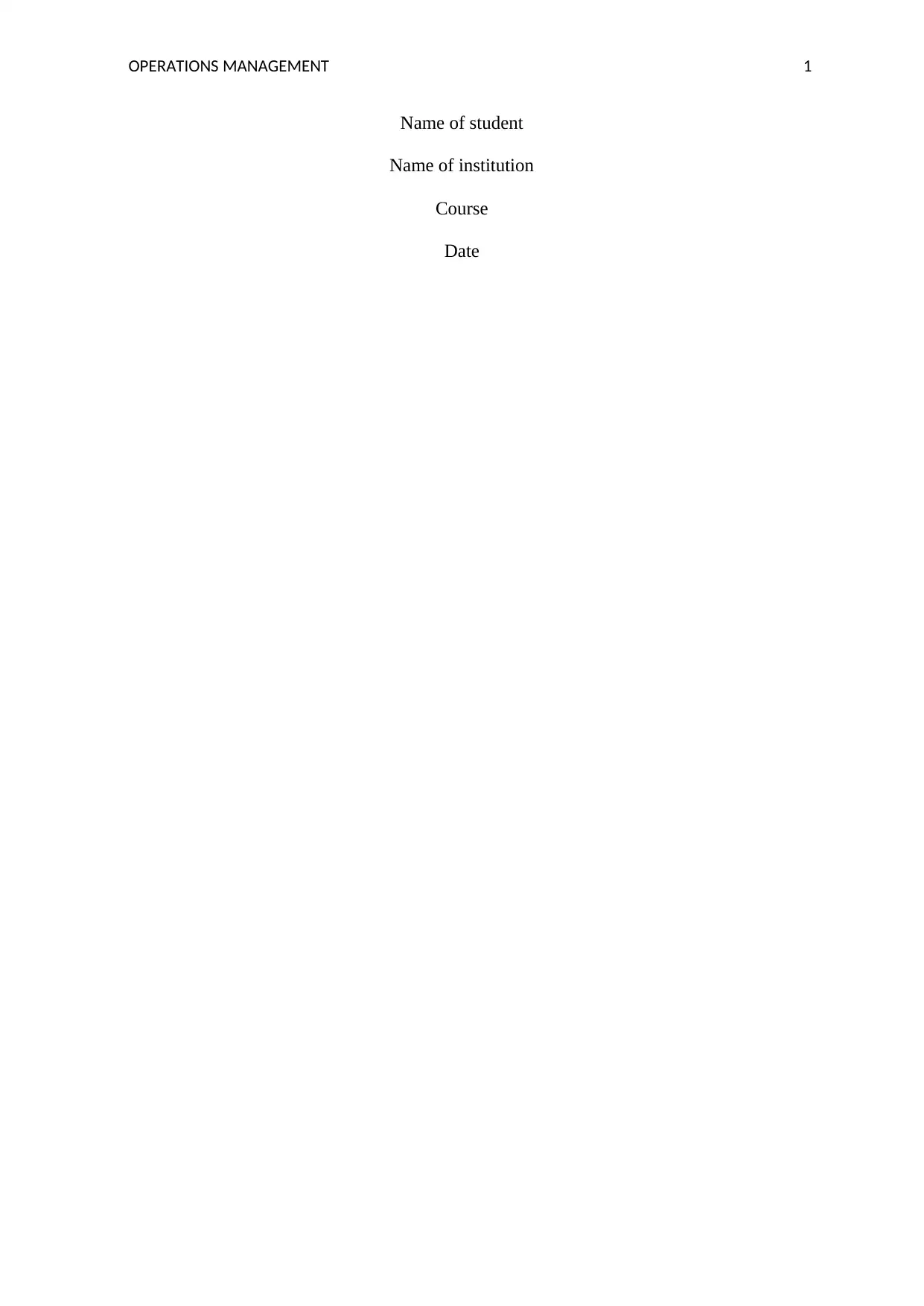
OPERATIONS MANAGEMENT 1
Name of student
Name of institution
Course
Date
Name of student
Name of institution
Course
Date
Paraphrase This Document
Need a fresh take? Get an instant paraphrase of this document with our AI Paraphraser
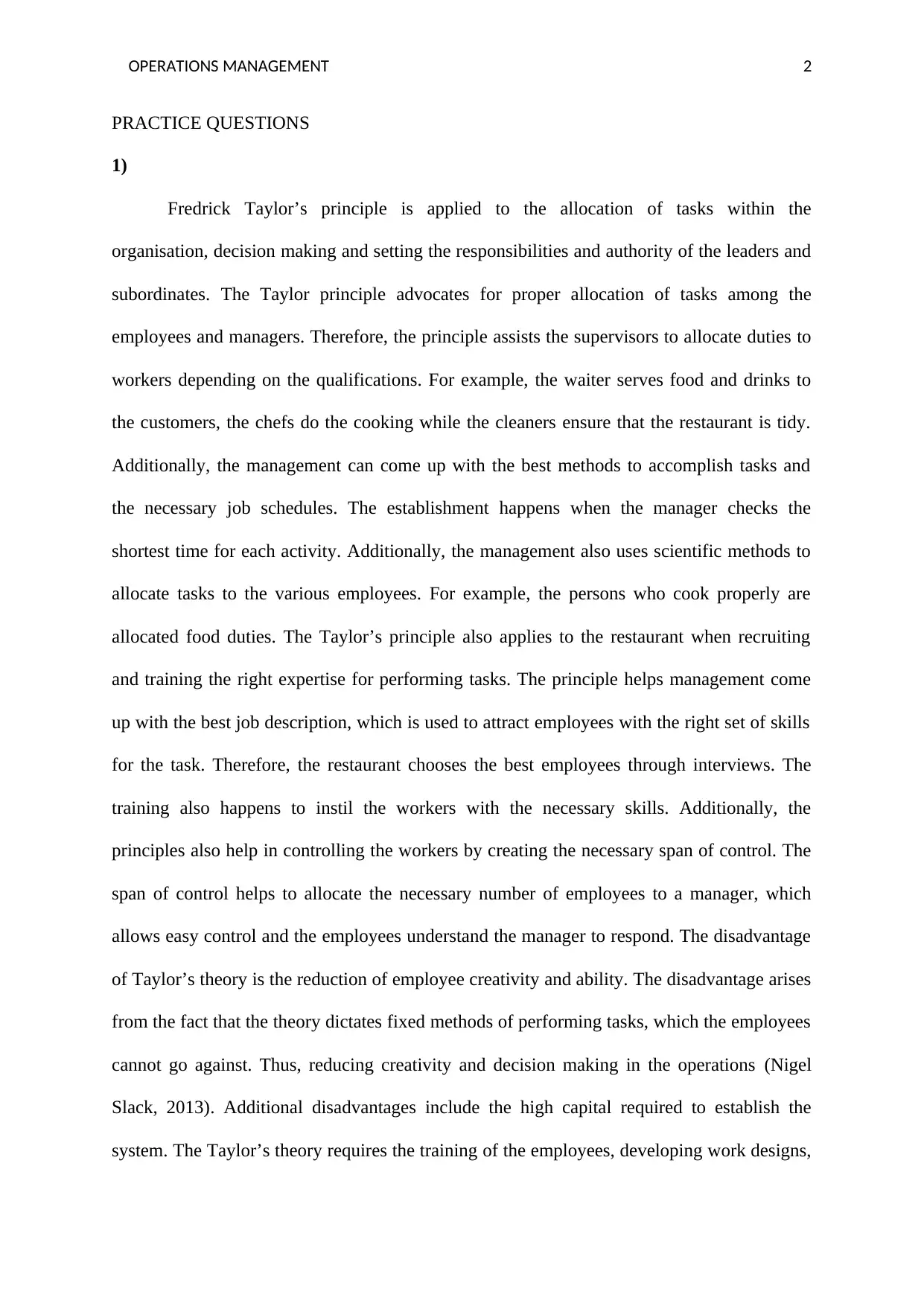
OPERATIONS MANAGEMENT 2
PRACTICE QUESTIONS
1)
Fredrick Taylor’s principle is applied to the allocation of tasks within the
organisation, decision making and setting the responsibilities and authority of the leaders and
subordinates. The Taylor principle advocates for proper allocation of tasks among the
employees and managers. Therefore, the principle assists the supervisors to allocate duties to
workers depending on the qualifications. For example, the waiter serves food and drinks to
the customers, the chefs do the cooking while the cleaners ensure that the restaurant is tidy.
Additionally, the management can come up with the best methods to accomplish tasks and
the necessary job schedules. The establishment happens when the manager checks the
shortest time for each activity. Additionally, the management also uses scientific methods to
allocate tasks to the various employees. For example, the persons who cook properly are
allocated food duties. The Taylor’s principle also applies to the restaurant when recruiting
and training the right expertise for performing tasks. The principle helps management come
up with the best job description, which is used to attract employees with the right set of skills
for the task. Therefore, the restaurant chooses the best employees through interviews. The
training also happens to instil the workers with the necessary skills. Additionally, the
principles also help in controlling the workers by creating the necessary span of control. The
span of control helps to allocate the necessary number of employees to a manager, which
allows easy control and the employees understand the manager to respond. The disadvantage
of Taylor’s theory is the reduction of employee creativity and ability. The disadvantage arises
from the fact that the theory dictates fixed methods of performing tasks, which the employees
cannot go against. Thus, reducing creativity and decision making in the operations (Nigel
Slack, 2013). Additional disadvantages include the high capital required to establish the
system. The Taylor’s theory requires the training of the employees, developing work designs,
PRACTICE QUESTIONS
1)
Fredrick Taylor’s principle is applied to the allocation of tasks within the
organisation, decision making and setting the responsibilities and authority of the leaders and
subordinates. The Taylor principle advocates for proper allocation of tasks among the
employees and managers. Therefore, the principle assists the supervisors to allocate duties to
workers depending on the qualifications. For example, the waiter serves food and drinks to
the customers, the chefs do the cooking while the cleaners ensure that the restaurant is tidy.
Additionally, the management can come up with the best methods to accomplish tasks and
the necessary job schedules. The establishment happens when the manager checks the
shortest time for each activity. Additionally, the management also uses scientific methods to
allocate tasks to the various employees. For example, the persons who cook properly are
allocated food duties. The Taylor’s principle also applies to the restaurant when recruiting
and training the right expertise for performing tasks. The principle helps management come
up with the best job description, which is used to attract employees with the right set of skills
for the task. Therefore, the restaurant chooses the best employees through interviews. The
training also happens to instil the workers with the necessary skills. Additionally, the
principles also help in controlling the workers by creating the necessary span of control. The
span of control helps to allocate the necessary number of employees to a manager, which
allows easy control and the employees understand the manager to respond. The disadvantage
of Taylor’s theory is the reduction of employee creativity and ability. The disadvantage arises
from the fact that the theory dictates fixed methods of performing tasks, which the employees
cannot go against. Thus, reducing creativity and decision making in the operations (Nigel
Slack, 2013). Additional disadvantages include the high capital required to establish the
system. The Taylor’s theory requires the training of the employees, developing work designs,
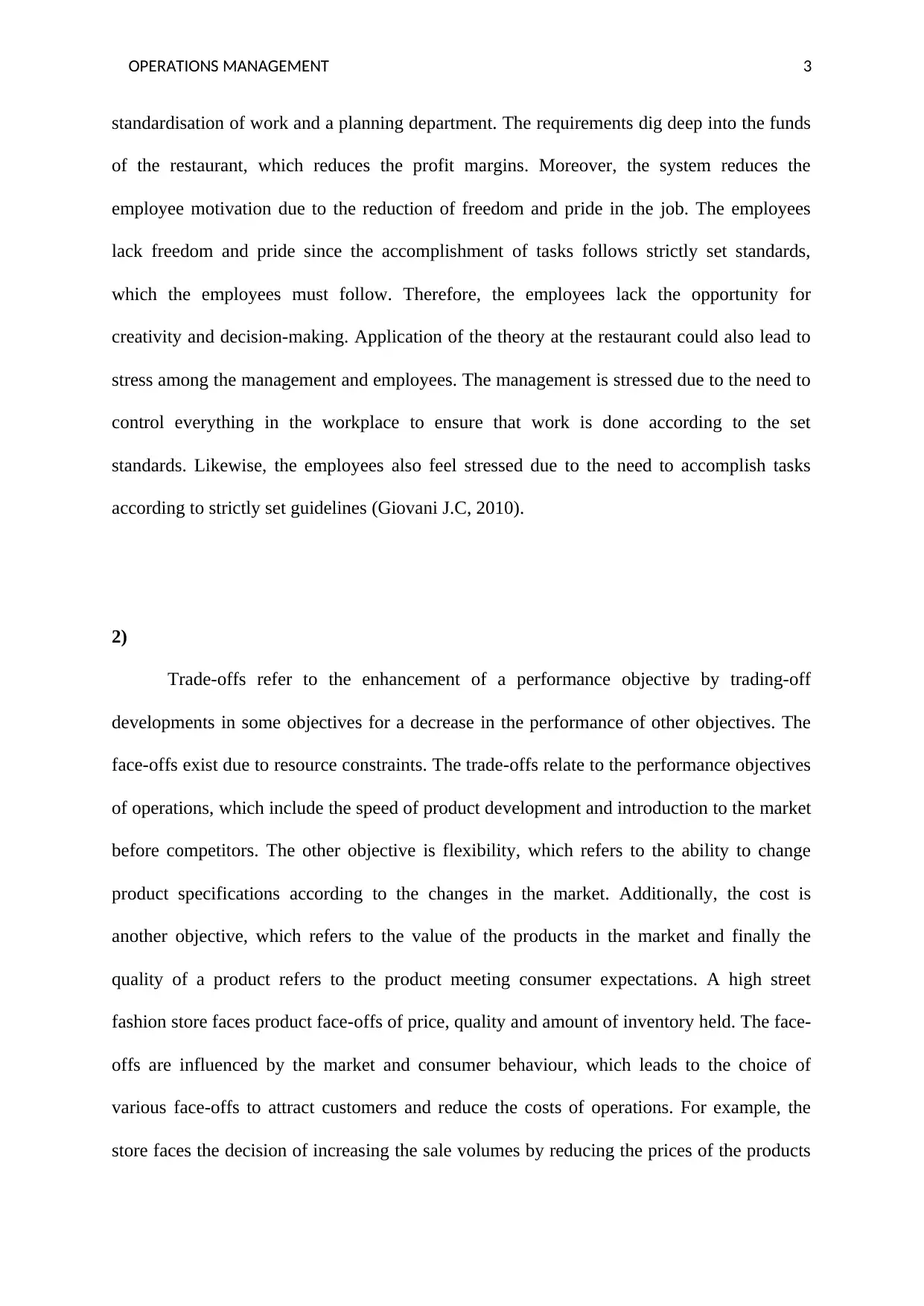
OPERATIONS MANAGEMENT 3
standardisation of work and a planning department. The requirements dig deep into the funds
of the restaurant, which reduces the profit margins. Moreover, the system reduces the
employee motivation due to the reduction of freedom and pride in the job. The employees
lack freedom and pride since the accomplishment of tasks follows strictly set standards,
which the employees must follow. Therefore, the employees lack the opportunity for
creativity and decision-making. Application of the theory at the restaurant could also lead to
stress among the management and employees. The management is stressed due to the need to
control everything in the workplace to ensure that work is done according to the set
standards. Likewise, the employees also feel stressed due to the need to accomplish tasks
according to strictly set guidelines (Giovani J.C, 2010).
2)
Trade-offs refer to the enhancement of a performance objective by trading-off
developments in some objectives for a decrease in the performance of other objectives. The
face-offs exist due to resource constraints. The trade-offs relate to the performance objectives
of operations, which include the speed of product development and introduction to the market
before competitors. The other objective is flexibility, which refers to the ability to change
product specifications according to the changes in the market. Additionally, the cost is
another objective, which refers to the value of the products in the market and finally the
quality of a product refers to the product meeting consumer expectations. A high street
fashion store faces product face-offs of price, quality and amount of inventory held. The face-
offs are influenced by the market and consumer behaviour, which leads to the choice of
various face-offs to attract customers and reduce the costs of operations. For example, the
store faces the decision of increasing the sale volumes by reducing the prices of the products
standardisation of work and a planning department. The requirements dig deep into the funds
of the restaurant, which reduces the profit margins. Moreover, the system reduces the
employee motivation due to the reduction of freedom and pride in the job. The employees
lack freedom and pride since the accomplishment of tasks follows strictly set standards,
which the employees must follow. Therefore, the employees lack the opportunity for
creativity and decision-making. Application of the theory at the restaurant could also lead to
stress among the management and employees. The management is stressed due to the need to
control everything in the workplace to ensure that work is done according to the set
standards. Likewise, the employees also feel stressed due to the need to accomplish tasks
according to strictly set guidelines (Giovani J.C, 2010).
2)
Trade-offs refer to the enhancement of a performance objective by trading-off
developments in some objectives for a decrease in the performance of other objectives. The
face-offs exist due to resource constraints. The trade-offs relate to the performance objectives
of operations, which include the speed of product development and introduction to the market
before competitors. The other objective is flexibility, which refers to the ability to change
product specifications according to the changes in the market. Additionally, the cost is
another objective, which refers to the value of the products in the market and finally the
quality of a product refers to the product meeting consumer expectations. A high street
fashion store faces product face-offs of price, quality and amount of inventory held. The face-
offs are influenced by the market and consumer behaviour, which leads to the choice of
various face-offs to attract customers and reduce the costs of operations. For example, the
store faces the decision of increasing the sale volumes by reducing the prices of the products
⊘ This is a preview!⊘
Do you want full access?
Subscribe today to unlock all pages.

Trusted by 1+ million students worldwide
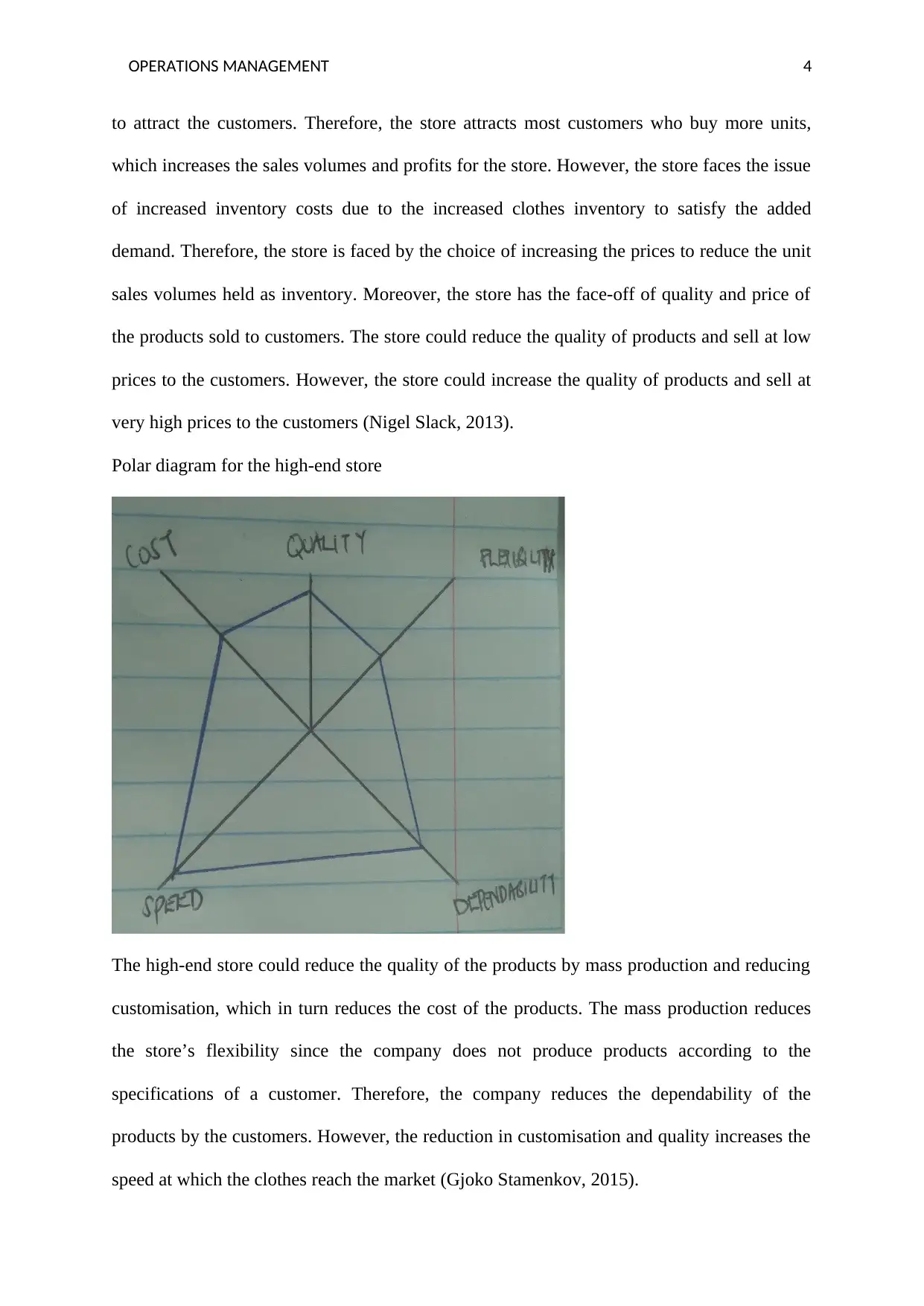
OPERATIONS MANAGEMENT 4
to attract the customers. Therefore, the store attracts most customers who buy more units,
which increases the sales volumes and profits for the store. However, the store faces the issue
of increased inventory costs due to the increased clothes inventory to satisfy the added
demand. Therefore, the store is faced by the choice of increasing the prices to reduce the unit
sales volumes held as inventory. Moreover, the store has the face-off of quality and price of
the products sold to customers. The store could reduce the quality of products and sell at low
prices to the customers. However, the store could increase the quality of products and sell at
very high prices to the customers (Nigel Slack, 2013).
Polar diagram for the high-end store
The high-end store could reduce the quality of the products by mass production and reducing
customisation, which in turn reduces the cost of the products. The mass production reduces
the store’s flexibility since the company does not produce products according to the
specifications of a customer. Therefore, the company reduces the dependability of the
products by the customers. However, the reduction in customisation and quality increases the
speed at which the clothes reach the market (Gjoko Stamenkov, 2015).
to attract the customers. Therefore, the store attracts most customers who buy more units,
which increases the sales volumes and profits for the store. However, the store faces the issue
of increased inventory costs due to the increased clothes inventory to satisfy the added
demand. Therefore, the store is faced by the choice of increasing the prices to reduce the unit
sales volumes held as inventory. Moreover, the store has the face-off of quality and price of
the products sold to customers. The store could reduce the quality of products and sell at low
prices to the customers. However, the store could increase the quality of products and sell at
very high prices to the customers (Nigel Slack, 2013).
Polar diagram for the high-end store
The high-end store could reduce the quality of the products by mass production and reducing
customisation, which in turn reduces the cost of the products. The mass production reduces
the store’s flexibility since the company does not produce products according to the
specifications of a customer. Therefore, the company reduces the dependability of the
products by the customers. However, the reduction in customisation and quality increases the
speed at which the clothes reach the market (Gjoko Stamenkov, 2015).
Paraphrase This Document
Need a fresh take? Get an instant paraphrase of this document with our AI Paraphraser
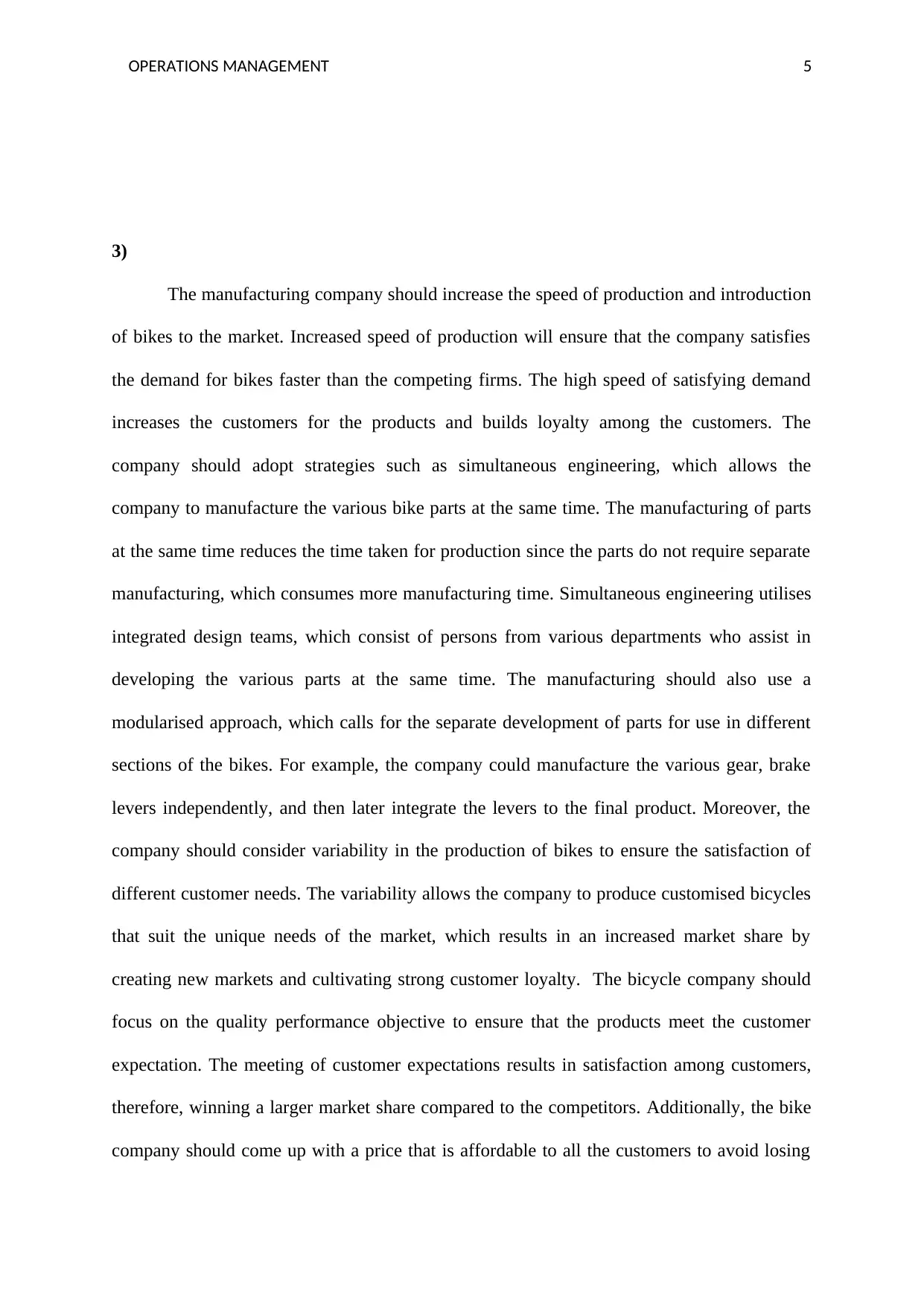
OPERATIONS MANAGEMENT 5
3)
The manufacturing company should increase the speed of production and introduction
of bikes to the market. Increased speed of production will ensure that the company satisfies
the demand for bikes faster than the competing firms. The high speed of satisfying demand
increases the customers for the products and builds loyalty among the customers. The
company should adopt strategies such as simultaneous engineering, which allows the
company to manufacture the various bike parts at the same time. The manufacturing of parts
at the same time reduces the time taken for production since the parts do not require separate
manufacturing, which consumes more manufacturing time. Simultaneous engineering utilises
integrated design teams, which consist of persons from various departments who assist in
developing the various parts at the same time. The manufacturing should also use a
modularised approach, which calls for the separate development of parts for use in different
sections of the bikes. For example, the company could manufacture the various gear, brake
levers independently, and then later integrate the levers to the final product. Moreover, the
company should consider variability in the production of bikes to ensure the satisfaction of
different customer needs. The variability allows the company to produce customised bicycles
that suit the unique needs of the market, which results in an increased market share by
creating new markets and cultivating strong customer loyalty. The bicycle company should
focus on the quality performance objective to ensure that the products meet the customer
expectation. The meeting of customer expectations results in satisfaction among customers,
therefore, winning a larger market share compared to the competitors. Additionally, the bike
company should come up with a price that is affordable to all the customers to avoid losing
3)
The manufacturing company should increase the speed of production and introduction
of bikes to the market. Increased speed of production will ensure that the company satisfies
the demand for bikes faster than the competing firms. The high speed of satisfying demand
increases the customers for the products and builds loyalty among the customers. The
company should adopt strategies such as simultaneous engineering, which allows the
company to manufacture the various bike parts at the same time. The manufacturing of parts
at the same time reduces the time taken for production since the parts do not require separate
manufacturing, which consumes more manufacturing time. Simultaneous engineering utilises
integrated design teams, which consist of persons from various departments who assist in
developing the various parts at the same time. The manufacturing should also use a
modularised approach, which calls for the separate development of parts for use in different
sections of the bikes. For example, the company could manufacture the various gear, brake
levers independently, and then later integrate the levers to the final product. Moreover, the
company should consider variability in the production of bikes to ensure the satisfaction of
different customer needs. The variability allows the company to produce customised bicycles
that suit the unique needs of the market, which results in an increased market share by
creating new markets and cultivating strong customer loyalty. The bicycle company should
focus on the quality performance objective to ensure that the products meet the customer
expectation. The meeting of customer expectations results in satisfaction among customers,
therefore, winning a larger market share compared to the competitors. Additionally, the bike
company should come up with a price that is affordable to all the customers to avoid losing
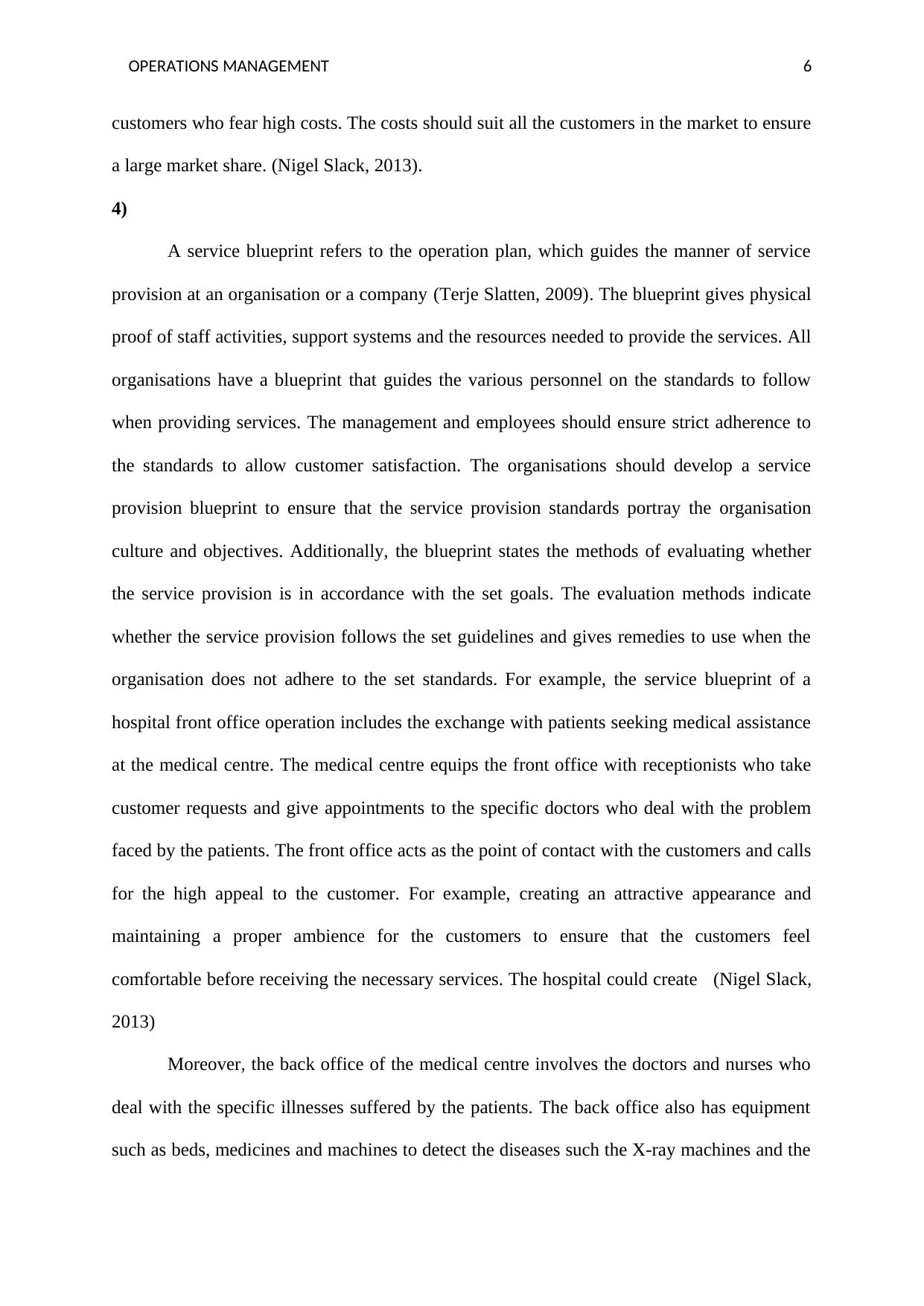
OPERATIONS MANAGEMENT 6
customers who fear high costs. The costs should suit all the customers in the market to ensure
a large market share. (Nigel Slack, 2013).
4)
A service blueprint refers to the operation plan, which guides the manner of service
provision at an organisation or a company (Terje Slatten, 2009). The blueprint gives physical
proof of staff activities, support systems and the resources needed to provide the services. All
organisations have a blueprint that guides the various personnel on the standards to follow
when providing services. The management and employees should ensure strict adherence to
the standards to allow customer satisfaction. The organisations should develop a service
provision blueprint to ensure that the service provision standards portray the organisation
culture and objectives. Additionally, the blueprint states the methods of evaluating whether
the service provision is in accordance with the set goals. The evaluation methods indicate
whether the service provision follows the set guidelines and gives remedies to use when the
organisation does not adhere to the set standards. For example, the service blueprint of a
hospital front office operation includes the exchange with patients seeking medical assistance
at the medical centre. The medical centre equips the front office with receptionists who take
customer requests and give appointments to the specific doctors who deal with the problem
faced by the patients. The front office acts as the point of contact with the customers and calls
for the high appeal to the customer. For example, creating an attractive appearance and
maintaining a proper ambience for the customers to ensure that the customers feel
comfortable before receiving the necessary services. The hospital could create (Nigel Slack,
2013)
Moreover, the back office of the medical centre involves the doctors and nurses who
deal with the specific illnesses suffered by the patients. The back office also has equipment
such as beds, medicines and machines to detect the diseases such the X-ray machines and the
customers who fear high costs. The costs should suit all the customers in the market to ensure
a large market share. (Nigel Slack, 2013).
4)
A service blueprint refers to the operation plan, which guides the manner of service
provision at an organisation or a company (Terje Slatten, 2009). The blueprint gives physical
proof of staff activities, support systems and the resources needed to provide the services. All
organisations have a blueprint that guides the various personnel on the standards to follow
when providing services. The management and employees should ensure strict adherence to
the standards to allow customer satisfaction. The organisations should develop a service
provision blueprint to ensure that the service provision standards portray the organisation
culture and objectives. Additionally, the blueprint states the methods of evaluating whether
the service provision is in accordance with the set goals. The evaluation methods indicate
whether the service provision follows the set guidelines and gives remedies to use when the
organisation does not adhere to the set standards. For example, the service blueprint of a
hospital front office operation includes the exchange with patients seeking medical assistance
at the medical centre. The medical centre equips the front office with receptionists who take
customer requests and give appointments to the specific doctors who deal with the problem
faced by the patients. The front office acts as the point of contact with the customers and calls
for the high appeal to the customer. For example, creating an attractive appearance and
maintaining a proper ambience for the customers to ensure that the customers feel
comfortable before receiving the necessary services. The hospital could create (Nigel Slack,
2013)
Moreover, the back office of the medical centre involves the doctors and nurses who
deal with the specific illnesses suffered by the patients. The back office also has equipment
such as beds, medicines and machines to detect the diseases such the X-ray machines and the
⊘ This is a preview!⊘
Do you want full access?
Subscribe today to unlock all pages.

Trusted by 1+ million students worldwide
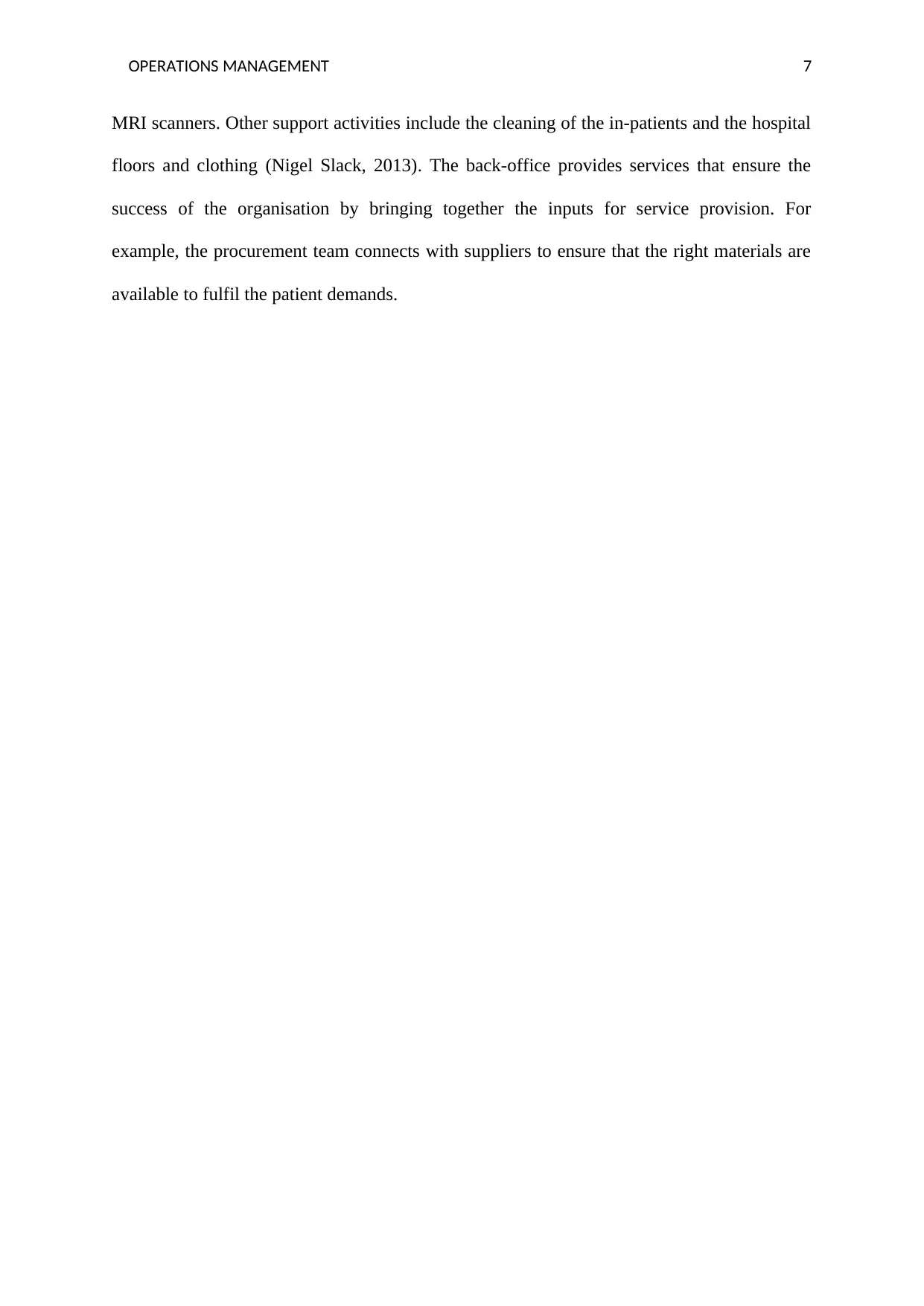
OPERATIONS MANAGEMENT 7
MRI scanners. Other support activities include the cleaning of the in-patients and the hospital
floors and clothing (Nigel Slack, 2013). The back-office provides services that ensure the
success of the organisation by bringing together the inputs for service provision. For
example, the procurement team connects with suppliers to ensure that the right materials are
available to fulfil the patient demands.
MRI scanners. Other support activities include the cleaning of the in-patients and the hospital
floors and clothing (Nigel Slack, 2013). The back-office provides services that ensure the
success of the organisation by bringing together the inputs for service provision. For
example, the procurement team connects with suppliers to ensure that the right materials are
available to fulfil the patient demands.
Paraphrase This Document
Need a fresh take? Get an instant paraphrase of this document with our AI Paraphraser
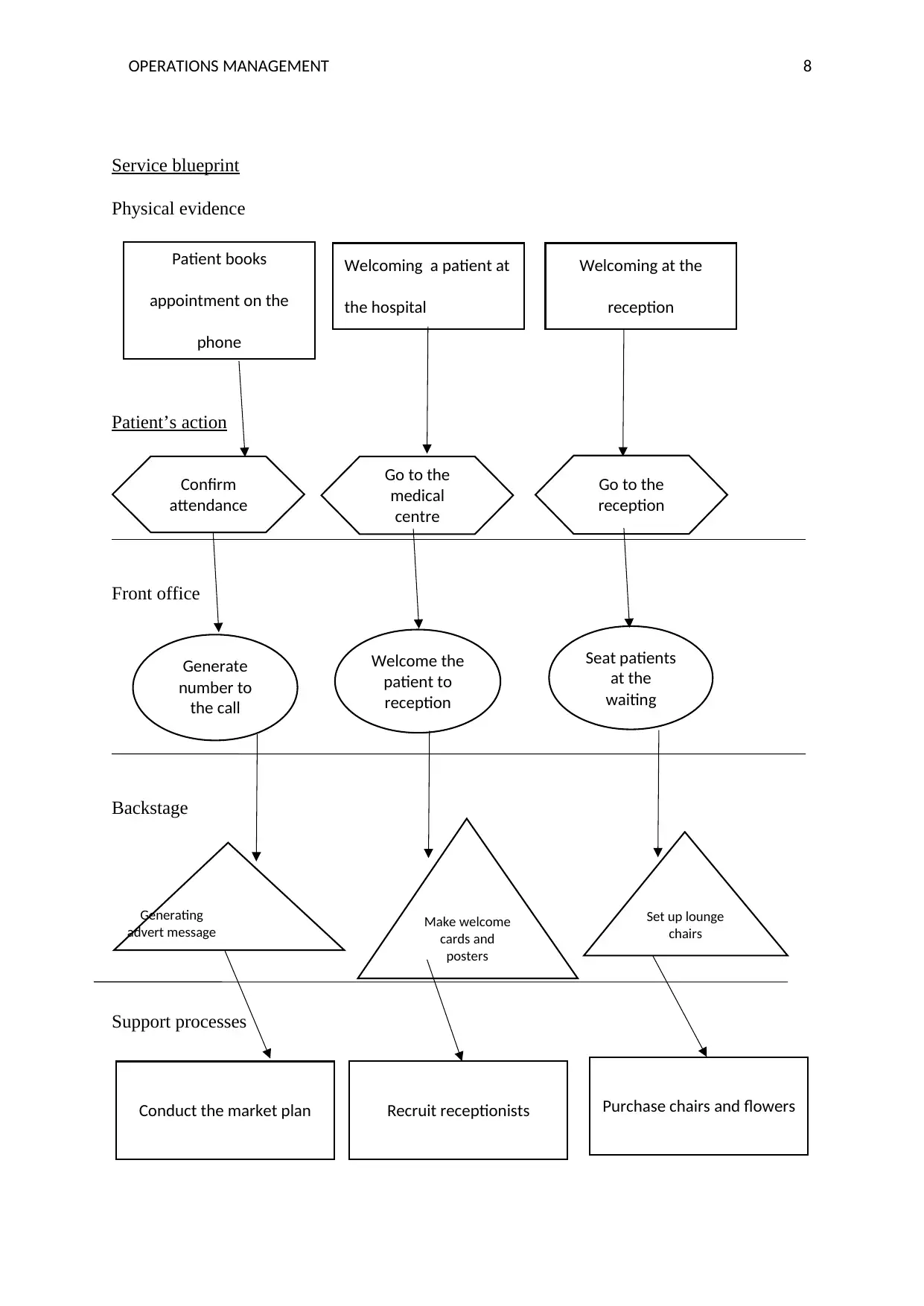
OPERATIONS MANAGEMENT 8
Service blueprint
Physical evidence
Patient’s action
Front office
Backstage
Support processes
Patient books
appointment on the
phone
Welcoming a patient at
the hospital
Welcoming at the
reception
Confirm
attendance
Go to the
reception
Go to the
medical
centre
Generate
number to
the call
centre
Welcome the
patient to
reception
Seat patients
at the
waiting
Generating
advert message Make welcome
cards and
posters
Set up lounge
chairs
Conduct the market plan Recruit receptionists Purchase chairs and flowers
Service blueprint
Physical evidence
Patient’s action
Front office
Backstage
Support processes
Patient books
appointment on the
phone
Welcoming a patient at
the hospital
Welcoming at the
reception
Confirm
attendance
Go to the
reception
Go to the
medical
centre
Generate
number to
the call
centre
Welcome the
patient to
reception
Seat patients
at the
waiting
Generating
advert message Make welcome
cards and
posters
Set up lounge
chairs
Conduct the market plan Recruit receptionists Purchase chairs and flowers
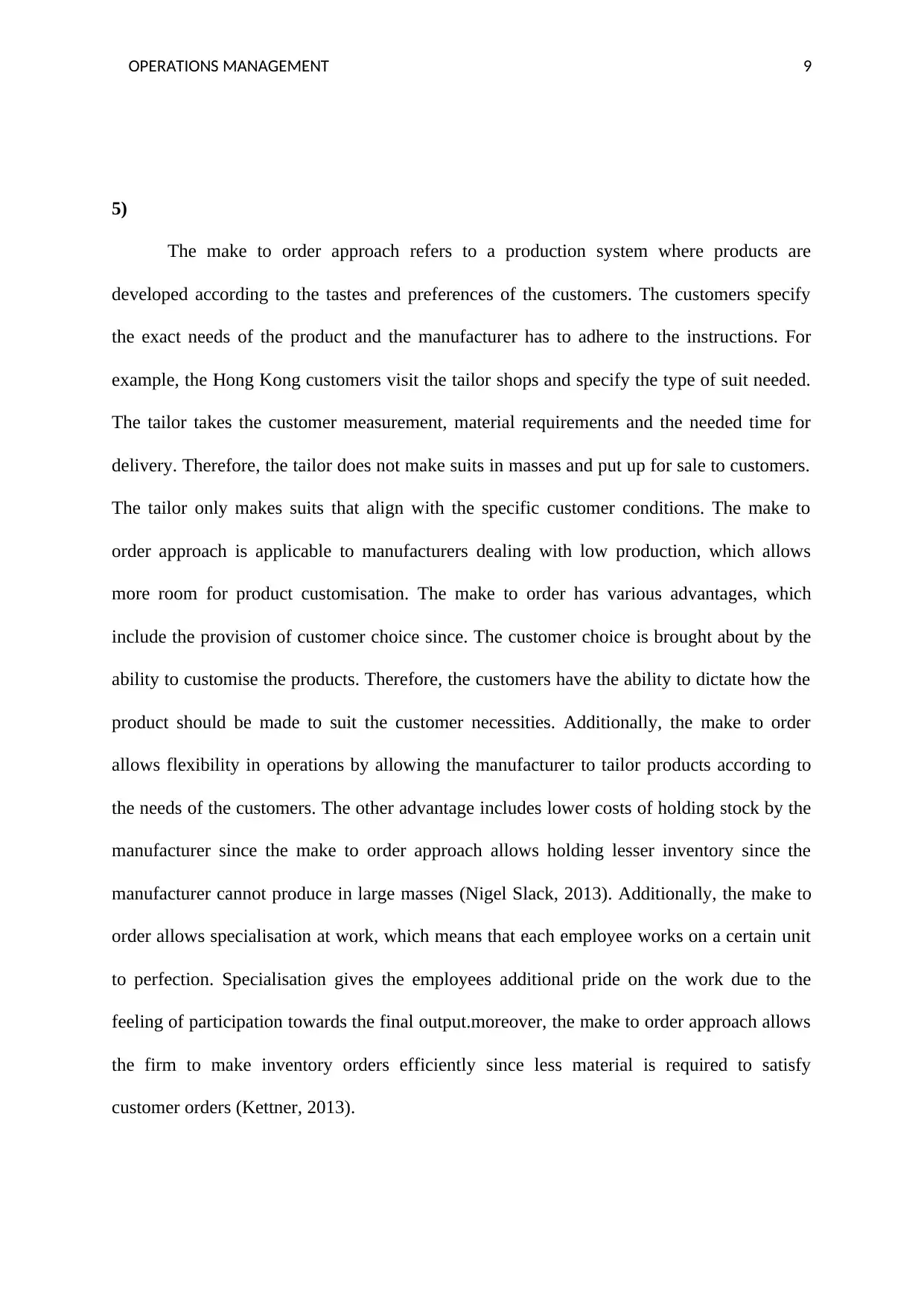
OPERATIONS MANAGEMENT 9
5)
The make to order approach refers to a production system where products are
developed according to the tastes and preferences of the customers. The customers specify
the exact needs of the product and the manufacturer has to adhere to the instructions. For
example, the Hong Kong customers visit the tailor shops and specify the type of suit needed.
The tailor takes the customer measurement, material requirements and the needed time for
delivery. Therefore, the tailor does not make suits in masses and put up for sale to customers.
The tailor only makes suits that align with the specific customer conditions. The make to
order approach is applicable to manufacturers dealing with low production, which allows
more room for product customisation. The make to order has various advantages, which
include the provision of customer choice since. The customer choice is brought about by the
ability to customise the products. Therefore, the customers have the ability to dictate how the
product should be made to suit the customer necessities. Additionally, the make to order
allows flexibility in operations by allowing the manufacturer to tailor products according to
the needs of the customers. The other advantage includes lower costs of holding stock by the
manufacturer since the make to order approach allows holding lesser inventory since the
manufacturer cannot produce in large masses (Nigel Slack, 2013). Additionally, the make to
order allows specialisation at work, which means that each employee works on a certain unit
to perfection. Specialisation gives the employees additional pride on the work due to the
feeling of participation towards the final output.moreover, the make to order approach allows
the firm to make inventory orders efficiently since less material is required to satisfy
customer orders (Kettner, 2013).
5)
The make to order approach refers to a production system where products are
developed according to the tastes and preferences of the customers. The customers specify
the exact needs of the product and the manufacturer has to adhere to the instructions. For
example, the Hong Kong customers visit the tailor shops and specify the type of suit needed.
The tailor takes the customer measurement, material requirements and the needed time for
delivery. Therefore, the tailor does not make suits in masses and put up for sale to customers.
The tailor only makes suits that align with the specific customer conditions. The make to
order approach is applicable to manufacturers dealing with low production, which allows
more room for product customisation. The make to order has various advantages, which
include the provision of customer choice since. The customer choice is brought about by the
ability to customise the products. Therefore, the customers have the ability to dictate how the
product should be made to suit the customer necessities. Additionally, the make to order
allows flexibility in operations by allowing the manufacturer to tailor products according to
the needs of the customers. The other advantage includes lower costs of holding stock by the
manufacturer since the make to order approach allows holding lesser inventory since the
manufacturer cannot produce in large masses (Nigel Slack, 2013). Additionally, the make to
order allows specialisation at work, which means that each employee works on a certain unit
to perfection. Specialisation gives the employees additional pride on the work due to the
feeling of participation towards the final output.moreover, the make to order approach allows
the firm to make inventory orders efficiently since less material is required to satisfy
customer orders (Kettner, 2013).
⊘ This is a preview!⊘
Do you want full access?
Subscribe today to unlock all pages.

Trusted by 1+ million students worldwide
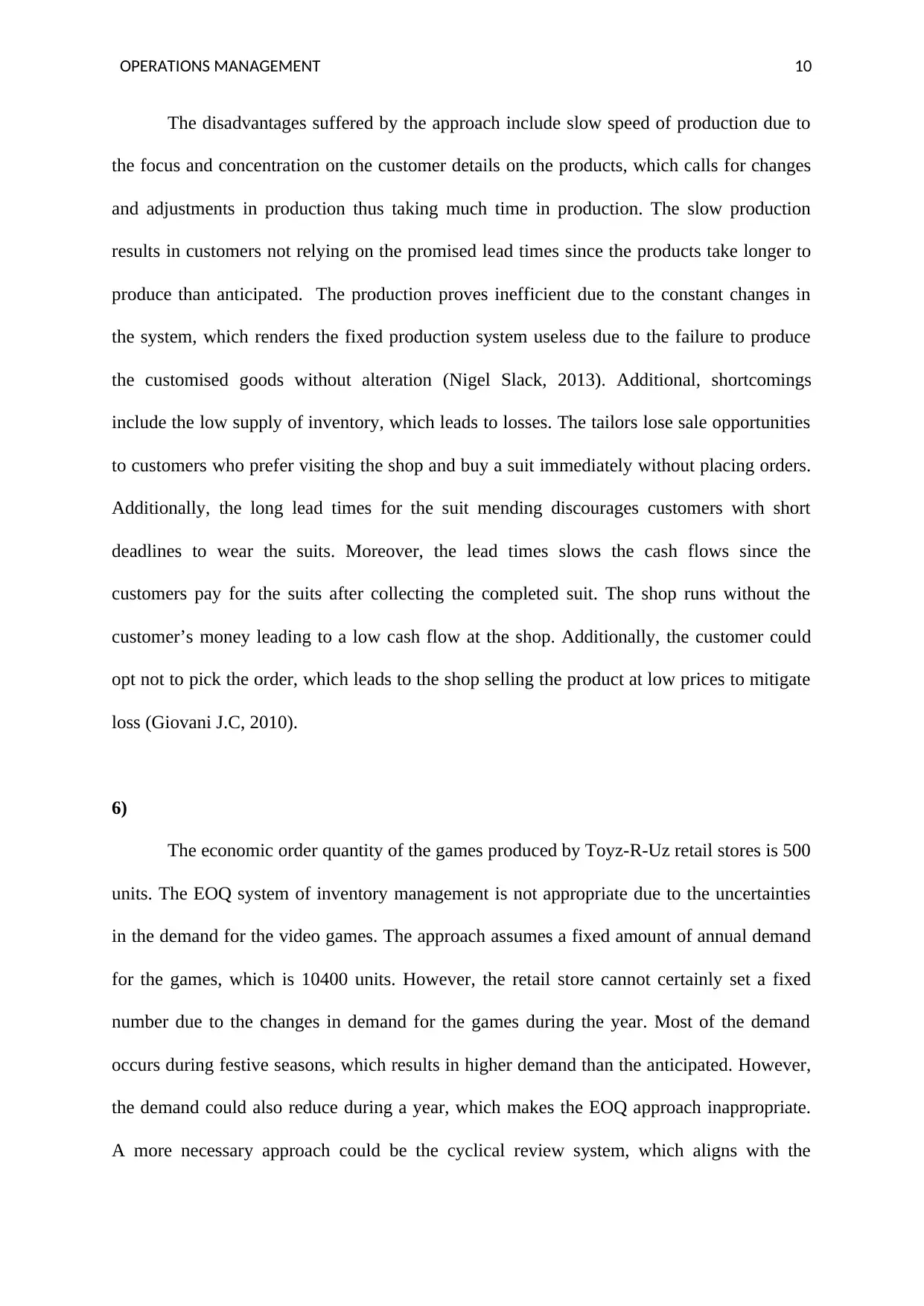
OPERATIONS MANAGEMENT 10
The disadvantages suffered by the approach include slow speed of production due to
the focus and concentration on the customer details on the products, which calls for changes
and adjustments in production thus taking much time in production. The slow production
results in customers not relying on the promised lead times since the products take longer to
produce than anticipated. The production proves inefficient due to the constant changes in
the system, which renders the fixed production system useless due to the failure to produce
the customised goods without alteration (Nigel Slack, 2013). Additional, shortcomings
include the low supply of inventory, which leads to losses. The tailors lose sale opportunities
to customers who prefer visiting the shop and buy a suit immediately without placing orders.
Additionally, the long lead times for the suit mending discourages customers with short
deadlines to wear the suits. Moreover, the lead times slows the cash flows since the
customers pay for the suits after collecting the completed suit. The shop runs without the
customer’s money leading to a low cash flow at the shop. Additionally, the customer could
opt not to pick the order, which leads to the shop selling the product at low prices to mitigate
loss (Giovani J.C, 2010).
6)
The economic order quantity of the games produced by Toyz-R-Uz retail stores is 500
units. The EOQ system of inventory management is not appropriate due to the uncertainties
in the demand for the video games. The approach assumes a fixed amount of annual demand
for the games, which is 10400 units. However, the retail store cannot certainly set a fixed
number due to the changes in demand for the games during the year. Most of the demand
occurs during festive seasons, which results in higher demand than the anticipated. However,
the demand could also reduce during a year, which makes the EOQ approach inappropriate.
A more necessary approach could be the cyclical review system, which aligns with the
The disadvantages suffered by the approach include slow speed of production due to
the focus and concentration on the customer details on the products, which calls for changes
and adjustments in production thus taking much time in production. The slow production
results in customers not relying on the promised lead times since the products take longer to
produce than anticipated. The production proves inefficient due to the constant changes in
the system, which renders the fixed production system useless due to the failure to produce
the customised goods without alteration (Nigel Slack, 2013). Additional, shortcomings
include the low supply of inventory, which leads to losses. The tailors lose sale opportunities
to customers who prefer visiting the shop and buy a suit immediately without placing orders.
Additionally, the long lead times for the suit mending discourages customers with short
deadlines to wear the suits. Moreover, the lead times slows the cash flows since the
customers pay for the suits after collecting the completed suit. The shop runs without the
customer’s money leading to a low cash flow at the shop. Additionally, the customer could
opt not to pick the order, which leads to the shop selling the product at low prices to mitigate
loss (Giovani J.C, 2010).
6)
The economic order quantity of the games produced by Toyz-R-Uz retail stores is 500
units. The EOQ system of inventory management is not appropriate due to the uncertainties
in the demand for the video games. The approach assumes a fixed amount of annual demand
for the games, which is 10400 units. However, the retail store cannot certainly set a fixed
number due to the changes in demand for the games during the year. Most of the demand
occurs during festive seasons, which results in higher demand than the anticipated. However,
the demand could also reduce during a year, which makes the EOQ approach inappropriate.
A more necessary approach could be the cyclical review system, which aligns with the
Paraphrase This Document
Need a fresh take? Get an instant paraphrase of this document with our AI Paraphraser
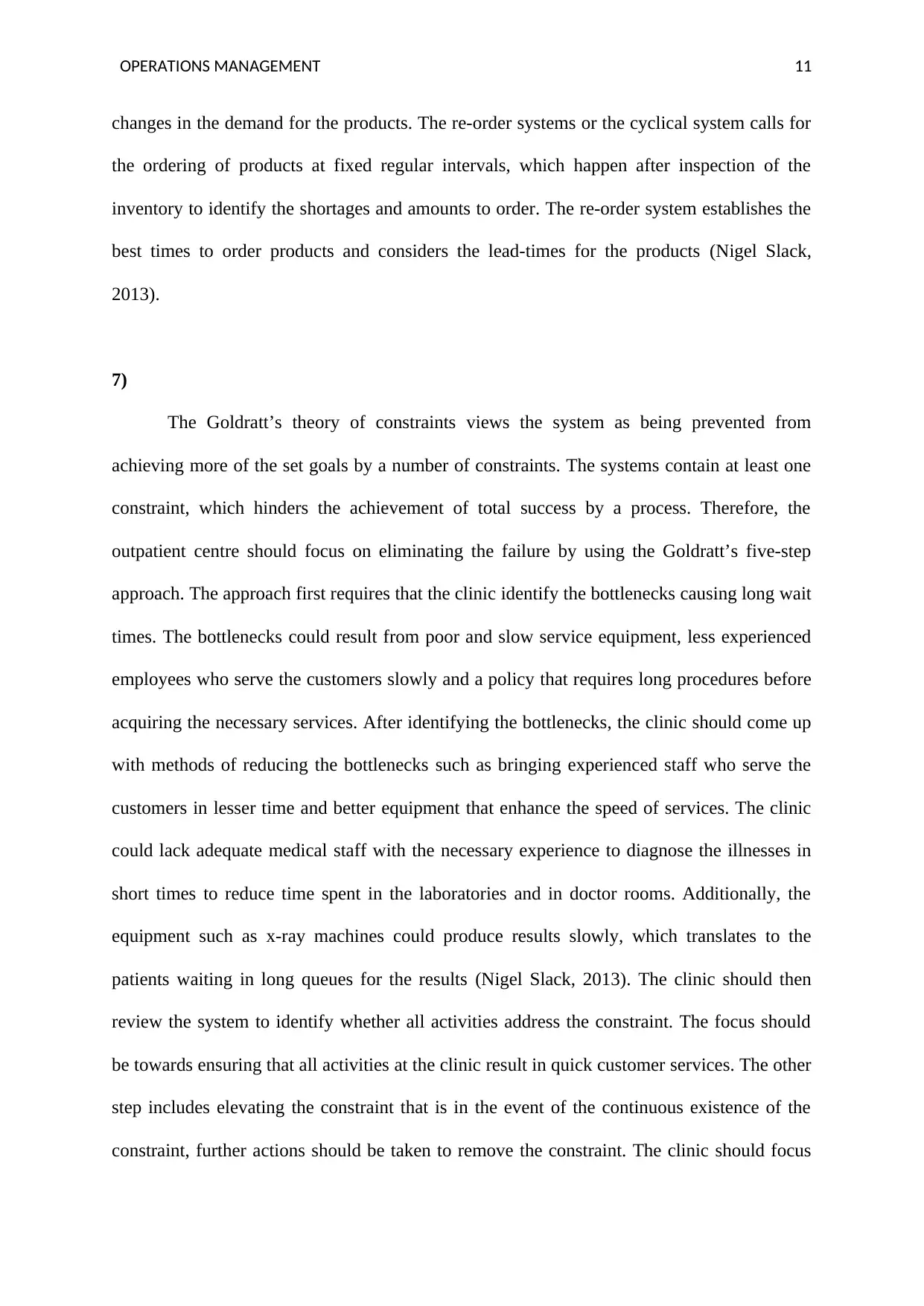
OPERATIONS MANAGEMENT 11
changes in the demand for the products. The re-order systems or the cyclical system calls for
the ordering of products at fixed regular intervals, which happen after inspection of the
inventory to identify the shortages and amounts to order. The re-order system establishes the
best times to order products and considers the lead-times for the products (Nigel Slack,
2013).
7)
The Goldratt’s theory of constraints views the system as being prevented from
achieving more of the set goals by a number of constraints. The systems contain at least one
constraint, which hinders the achievement of total success by a process. Therefore, the
outpatient centre should focus on eliminating the failure by using the Goldratt’s five-step
approach. The approach first requires that the clinic identify the bottlenecks causing long wait
times. The bottlenecks could result from poor and slow service equipment, less experienced
employees who serve the customers slowly and a policy that requires long procedures before
acquiring the necessary services. After identifying the bottlenecks, the clinic should come up
with methods of reducing the bottlenecks such as bringing experienced staff who serve the
customers in lesser time and better equipment that enhance the speed of services. The clinic
could lack adequate medical staff with the necessary experience to diagnose the illnesses in
short times to reduce time spent in the laboratories and in doctor rooms. Additionally, the
equipment such as x-ray machines could produce results slowly, which translates to the
patients waiting in long queues for the results (Nigel Slack, 2013). The clinic should then
review the system to identify whether all activities address the constraint. The focus should
be towards ensuring that all activities at the clinic result in quick customer services. The other
step includes elevating the constraint that is in the event of the continuous existence of the
constraint, further actions should be taken to remove the constraint. The clinic should focus
changes in the demand for the products. The re-order systems or the cyclical system calls for
the ordering of products at fixed regular intervals, which happen after inspection of the
inventory to identify the shortages and amounts to order. The re-order system establishes the
best times to order products and considers the lead-times for the products (Nigel Slack,
2013).
7)
The Goldratt’s theory of constraints views the system as being prevented from
achieving more of the set goals by a number of constraints. The systems contain at least one
constraint, which hinders the achievement of total success by a process. Therefore, the
outpatient centre should focus on eliminating the failure by using the Goldratt’s five-step
approach. The approach first requires that the clinic identify the bottlenecks causing long wait
times. The bottlenecks could result from poor and slow service equipment, less experienced
employees who serve the customers slowly and a policy that requires long procedures before
acquiring the necessary services. After identifying the bottlenecks, the clinic should come up
with methods of reducing the bottlenecks such as bringing experienced staff who serve the
customers in lesser time and better equipment that enhance the speed of services. The clinic
could lack adequate medical staff with the necessary experience to diagnose the illnesses in
short times to reduce time spent in the laboratories and in doctor rooms. Additionally, the
equipment such as x-ray machines could produce results slowly, which translates to the
patients waiting in long queues for the results (Nigel Slack, 2013). The clinic should then
review the system to identify whether all activities address the constraint. The focus should
be towards ensuring that all activities at the clinic result in quick customer services. The other
step includes elevating the constraint that is in the event of the continuous existence of the
constraint, further actions should be taken to remove the constraint. The clinic should focus
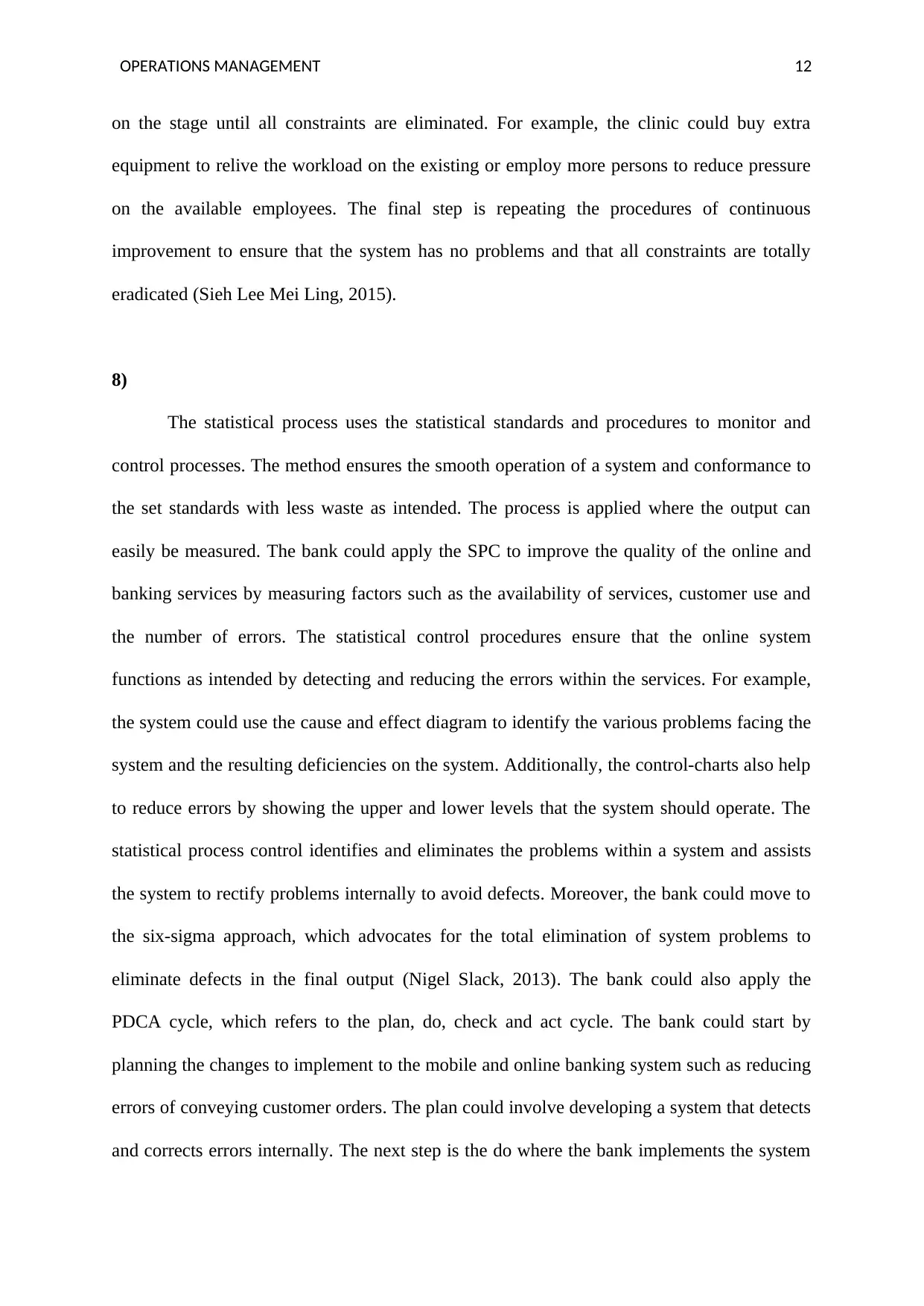
OPERATIONS MANAGEMENT 12
on the stage until all constraints are eliminated. For example, the clinic could buy extra
equipment to relive the workload on the existing or employ more persons to reduce pressure
on the available employees. The final step is repeating the procedures of continuous
improvement to ensure that the system has no problems and that all constraints are totally
eradicated (Sieh Lee Mei Ling, 2015).
8)
The statistical process uses the statistical standards and procedures to monitor and
control processes. The method ensures the smooth operation of a system and conformance to
the set standards with less waste as intended. The process is applied where the output can
easily be measured. The bank could apply the SPC to improve the quality of the online and
banking services by measuring factors such as the availability of services, customer use and
the number of errors. The statistical control procedures ensure that the online system
functions as intended by detecting and reducing the errors within the services. For example,
the system could use the cause and effect diagram to identify the various problems facing the
system and the resulting deficiencies on the system. Additionally, the control-charts also help
to reduce errors by showing the upper and lower levels that the system should operate. The
statistical process control identifies and eliminates the problems within a system and assists
the system to rectify problems internally to avoid defects. Moreover, the bank could move to
the six-sigma approach, which advocates for the total elimination of system problems to
eliminate defects in the final output (Nigel Slack, 2013). The bank could also apply the
PDCA cycle, which refers to the plan, do, check and act cycle. The bank could start by
planning the changes to implement to the mobile and online banking system such as reducing
errors of conveying customer orders. The plan could involve developing a system that detects
and corrects errors internally. The next step is the do where the bank implements the system
on the stage until all constraints are eliminated. For example, the clinic could buy extra
equipment to relive the workload on the existing or employ more persons to reduce pressure
on the available employees. The final step is repeating the procedures of continuous
improvement to ensure that the system has no problems and that all constraints are totally
eradicated (Sieh Lee Mei Ling, 2015).
8)
The statistical process uses the statistical standards and procedures to monitor and
control processes. The method ensures the smooth operation of a system and conformance to
the set standards with less waste as intended. The process is applied where the output can
easily be measured. The bank could apply the SPC to improve the quality of the online and
banking services by measuring factors such as the availability of services, customer use and
the number of errors. The statistical control procedures ensure that the online system
functions as intended by detecting and reducing the errors within the services. For example,
the system could use the cause and effect diagram to identify the various problems facing the
system and the resulting deficiencies on the system. Additionally, the control-charts also help
to reduce errors by showing the upper and lower levels that the system should operate. The
statistical process control identifies and eliminates the problems within a system and assists
the system to rectify problems internally to avoid defects. Moreover, the bank could move to
the six-sigma approach, which advocates for the total elimination of system problems to
eliminate defects in the final output (Nigel Slack, 2013). The bank could also apply the
PDCA cycle, which refers to the plan, do, check and act cycle. The bank could start by
planning the changes to implement to the mobile and online banking system such as reducing
errors of conveying customer orders. The plan could involve developing a system that detects
and corrects errors internally. The next step is the do where the bank implements the system
⊘ This is a preview!⊘
Do you want full access?
Subscribe today to unlock all pages.

Trusted by 1+ million students worldwide
1 out of 27
Your All-in-One AI-Powered Toolkit for Academic Success.
+13062052269
info@desklib.com
Available 24*7 on WhatsApp / Email
![[object Object]](/_next/static/media/star-bottom.7253800d.svg)
Unlock your academic potential
Copyright © 2020–2025 A2Z Services. All Rights Reserved. Developed and managed by ZUCOL.